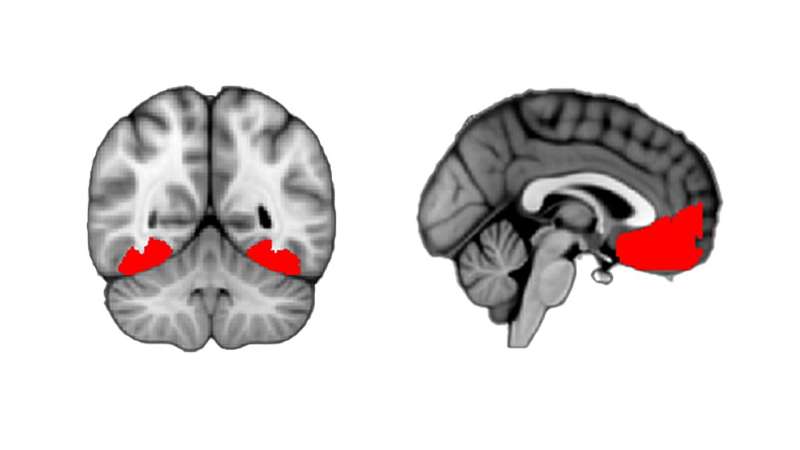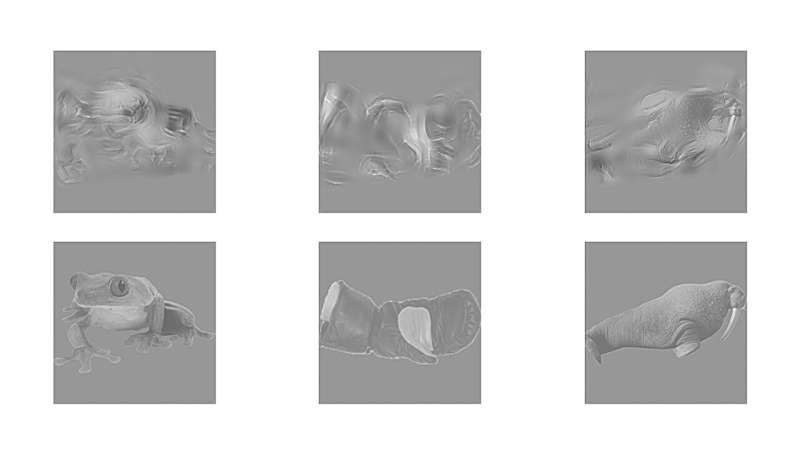This article has been reviewed according to Science X's editorial process and policies. Editors have highlighted the following attributes while ensuring the content's credibility:
fact-checked
peer-reviewed publication
trusted source
proofread
Brain-imaging study reveals curiosity as it emerges

You look up into the clear blue sky and see something you can't quite identify. Is it a balloon? A plane? A UFO? You're curious, right? A research team based at Columbia's Zuckerman Institute has for the first time witnessed what is happening in the human brain when feelings of curiosity like this arise.
In a study published in the Journal of Neuroscience, the scientists revealed brain areas that appear to assess the degree of uncertainty in visually ambiguous situations, giving rise to subjective feelings of curiosity.
"Curiosity has deep biological origins," said corresponding author Jacqueline Gottlieb, Ph.D., a principal investigator at the Zuckerman Institute. The primary evolutionary benefit of curiosity, she added, is to encourage living things to explore their world in ways that help them survive.
"What distinguishes human curiosity is that it drives us to explore much more broadly than other animals, and often just because we want to find things out, not because we are seeking a material reward or survival benefit," said Dr. Gottlieb, who is also a professor of neuroscience at Columbia's Vagelos College of Physicians and Surgeons. "This leads to a lot of our creativity."
Joining Dr. Gottlieb on the research were Michael Cohanpour, Ph.D., a former graduate student at Columbia (now a data scientist with dsm-firmenich), and Mariam Aly, Ph.D., also previously at Columbia and now an acting associate professor of psychology at the University of California, Berkeley.
In the study, researchers employed a noninvasive, widely used technology to measure changes in the blood-oxygen levels in the brains of 32 volunteers. Called functional magnetic resonance imaging, or fMRI, the technology enabled the scientists to record how much oxygen different parts of the subjects' brains consumed as they viewed images. The more oxygen a brain region consumes, the more active it is.
To unveil those brain areas involved in curiosity, the research team presented participants with special images known as texforms. These are images of objects, such as a walrus, frog, tank or hat, that have been distorted to various degrees to make them more or less difficult to recognize.
The researchers asked participants to rate their confidence and curiosity about each texform, and found that the two ratings were inversely related. The more confident subjects were that they knew what the texform depicts, the less curious they were about it. Conversely, the less confident subjects were that they could guess what the texform was, the more curious they were about it.
Using fMRI, the researchers then viewed what was happening in the brain as the subjects were presented with texforms. The brain-scan data showed high activity in the occipitotemporal cortex (OTC), a region located just above your ears, which has long been known to be involved in vision and in recognizing categories of objects.

Based on previous studies, the researchers expected that when they presented participants with clear images, this brain region would show distinct activity patterns for animate and inanimate objects. "You can think of each pattern as a 'barcode' identifying the texform category," Dr. Gottlied said.
The researchers used these patterns to develop a measure, which they dubbed "OTC uncertainty," of how uncertain this cortical area was about the category of a distorted texform. They showed that, when subjects were less curious about a texform, their OTC activity corresponded to only one barcode, as if it clearly identified whether the image belonged to the animate or the inanimate category. In contrast, when subjects were more curious, their OTC had characteristics of both barcodes, as if it could not clearly identify the image category.
Also active during the texform presentations were two regions in the front of the brain. One is the anterior cingulate cortex, which previous studies implicated in information gathering. The other is the ventromedial prefrontal cortex (vmPFC), which is involved in monitoring a person's subjective perceptions of value and confidence about different situations. In the new study, both areas were more active when subjects reported being more confident in knowing a texform's identity (and thus, less curious to see the clarified image).
Importantly, said Dr. Gottlieb, vmPFC activity seemed to provide a neurological bridge between the subjective feeling of curiosity and the OTC certainty measure. It's as though this region read out the uncertainty encoded by the distributed activity pattern in the OTC and helped a person decide if they needed to be curious about the texform.
"This is really the first time we can link the subjective feeling of curiosity about information to the way your brain represents that information," Dr. Gottlieb said.
The study has two important implications, Dr. Gottlieb said. First, although the study focused on perceptual curiosity elicited by visual stimuli, people experience other forms of curiosity, such as curiosity about trivia questions and factual matters (i.e. how tall is the Eiffel tower?) or social curiosity (which restaurant did my friends go to last night?).
One intriguing possibility of the study, she noted, is that the mechanism it has uncovered may generalize to other forms of curiosity. For example, an fMRI study investigating sounds of varying recognizability may show that auditory areas in the brain convey the uncertainty regarding the sound and the vmPFC reads out this uncertainty to determine curiosity.
A second possibility on Dr. Gottlieb's mind is that the findings could have diagnostic and even therapeutic implications for those with depression, apathy or anhedonia (the inability to feel pleasure), which are conditions often marked by a lack of curiosity.
"Curiosity entails a sort of enthusiasm, a willingness to expend energy and investigate your surroundings. And it's intrinsically motivated, meaning that nobody is paying you to be curious; you are curious merely based on the hope that something good will come when you learn," Dr. Gottlieb said. "Those are just some of the amazing things about curiosity."
More information: Michael Cohanpour et al, Neural Representations of Sensory Uncertainty and Confidence are Associated with Perceptual Curiosity, The Journal of Neuroscience (2024). DOI: 10.1523/JNEUROSCI.0974-23.2024





















